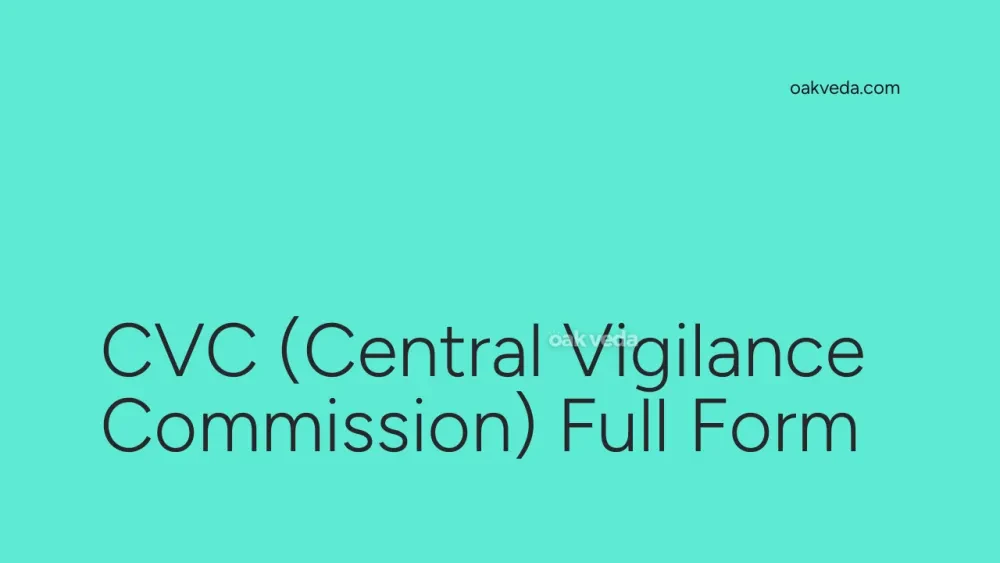
What is the Full Form of CVC?
The full form of CVC is Central Vigilance Commission. This important Indian governmental body plays a crucial role in maintaining integrity and transparency within the country's administrative system.
What is Central Vigilance Commission?
The Central Vigilance Commission (CVC) is an apex anti-corruption institution in India. Established in 1964, it serves as the primary agency for monitoring all vigilance activities under the Central Government and advising various authorities in Central Government organizations in planning, executing, reviewing, and reforming their vigilance work.
Origin and Development of Central Vigilance Commission
The CVC was born out of the recommendations made by the Committee on Prevention of Corruption, headed by Shri K. Santhanam. On February 11, 1964, the Indian Government passed a resolution to create this independent body to guide and oversee vigilance activities across central government organizations.
Initially functioning as an advisory body, the CVC gained statutory status in 2003 when the Indian Parliament passed the Central Vigilance Commission Act. This legislative backing significantly enhanced the commission's authority and independence.
How does Central Vigilance Commission work?
The CVC operates as an autonomous entity, free from executive authority influence. It works closely with various government departments and agencies to ensure transparency and prevent corruption. The commission's working mechanism involves:
- Conducting investigations
- Advising on vigilance matters
- Overseeing the functioning of the Central Bureau of Investigation (CBI)
- Receiving and acting on complaints of corruption
Functions of Central Vigilance Commission
The CVC's primary functions include:
-
Oversight of DSPE: Examining inquiries conducted by the Delhi Special Police Establishment (DSPE) related to offenses under the Prevention of Corruption Act.
-
Corruption Investigation: Investigating any transaction where a public servant is suspected of engaging in corrupt practices.
-
Whistleblower Protection: Receiving and investigating complaints under the Public Interest Disclosure and Protection of Informers Resolution (PIDPI), also known as the Whistleblower Resolution.
-
Advisory Role: Providing guidance to various Central Government organizations on vigilance administration.
-
Policy Formulation: Recommending measures to combat corruption and improve administrative processes.
Applications of Central Vigilance Commission
The CVC's work has wide-ranging applications across the Indian government:
- Public Sector Undertakings: Overseeing vigilance activities in state-owned enterprises.
- Government Departments: Ensuring transparency in ministerial operations.
- Banking Sector: Investigating financial irregularities in public sector banks.
- Infrastructure Projects: Monitoring large-scale government projects for potential corruption.
Features of Central Vigilance Commission
Key features of the CVC include:
- Independence: Operates autonomously, free from executive influence.
- Statutory Authority: Backed by the Central Vigilance Commission Act, 2003.
- Multi-member Body: Comprises a Central Vigilance Commissioner as chairperson and up to two Vigilance Commissioners as members.
- Advisory Powers: Provides recommendations to government organizations on vigilance matters.
- Investigative Authority: Can initiate inquiries into suspected corruption cases.
Benefits of Central Vigilance Commission
The existence and functioning of the CVC offer several benefits:
- Corruption Deterrence: Acts as a watchdog, discouraging corrupt practices in government.
- Transparency Promotion: Encourages openness in administrative processes.
- Public Trust: Enhances citizen confidence in government institutions.
- Systemic Improvements: Recommends reforms to prevent corruption at the structural level.
- Whistleblower Protection: Provides a safe channel for reporting corruption.
Limitations or Challenges of Central Vigilance Commission
Despite its crucial role, the CVC faces several challenges:
- Limited Jurisdiction: Authority restricted to central government organizations.
- Advisory Nature: Recommendations are not always binding on the government.
- Resource Constraints: Limited manpower and financial resources to handle the vast scope of work.
- Political Interference: Occasional allegations of political influence in high-profile cases.
- Bureaucratic Delays: Investigations and proceedings can be time-consuming.
Future Developments in Central Vigilance Commission
As India continues its fight against corruption, the CVC is likely to see several developments:
- Technological Integration: Increased use of data analytics and AI for detecting corruption patterns.
- Expanded Jurisdiction: Potential extension of authority to cover more organizations.
- International Cooperation: Enhanced collaboration with global anti-corruption bodies.
- Legislative Strengthening: Possible amendments to the CVC Act to address current limitations.
- Public Engagement: Greater emphasis on citizen participation in vigilance activities.
FAQs on CVC Full Form
-
When was the CVC established? The CVC was established on February 11, 1964.
-
Who was India's first Chief Vigilance Commissioner? Nittoor Srinivasa Rau was appointed as India's first Chief Vigilance Commissioner.
-
What is the composition of the CVC? The CVC typically comprises a Central Vigilance Commissioner as chairperson and up to two Vigilance Commissioners as members.
-
Does the CVC have jurisdiction over state governments? No, the CVC's jurisdiction is limited to central government organizations and does not extend to state governments.
-
Can the public directly approach the CVC with complaints? Yes, the CVC has mechanisms in place for receiving and acting on public complaints about corruption in central government organizations.
In conclusion, the Central Vigilance Commission, the full form of CVC, plays a vital role in India's anti-corruption efforts. As an autonomous body with statutory backing, it continues to evolve and adapt to the changing landscape of governance and public administration in India.
You may be interested in:
- LIC (Life Insurance Corporation of India)
- B.Ed (Bachelor of Education): Full Form and Guide
- NIFTY (Full Form): National Stock Exchange Fifty
- CNC (Computerised Numerical Control) Full Form
- AAI (Airport Authority of India): Full Form Explained
- CRISIL (Credit Rating Information Services of India Limited)

